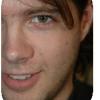I like the simplicity - the focus on content is a good idea, as is the decreased loading-time for dialup users.
One thing... your table seems to be only using up part of the screen (presumably for readibility 800x600 resolution screens). While this readibility is good, it means that extra space on the right is going to waste on higher resolutions. By using percentage values, you can have the table cells stretch out to use up all avaliable space. Note that you could still use a fixed value for the navigation bar on the left, so that only the main content is resized.
Once again, this isnt actually something necessary, but it might help increase readibility on higher resolution monitors.

Oh, and if you want, you could consider using an externally referenced Cascading Style Sheet for your site. This would allow you to have nice formatting (still nice and simple), without a performance hit, and loaded only once for your whole site (56k friendly

), as well as to help maintain a nice consistent look throughout the site as you add more pages. You can make changes to a CSS file linked in this way and update the look of the entire site from one place, and you wouldnt have to put so much formatting information within the document itself (WHOO!! less coding

). A decent CSS tutorial can be found
here, and CSS doesnt take very long at all to learn and implement, and can save you plenty of time in the long run as your site expands. [/CSS plug]
(heh, and I''m not saying you
must use CSS, or even
should, just presenting it as an option (but trust me its a pretty good one

)).








